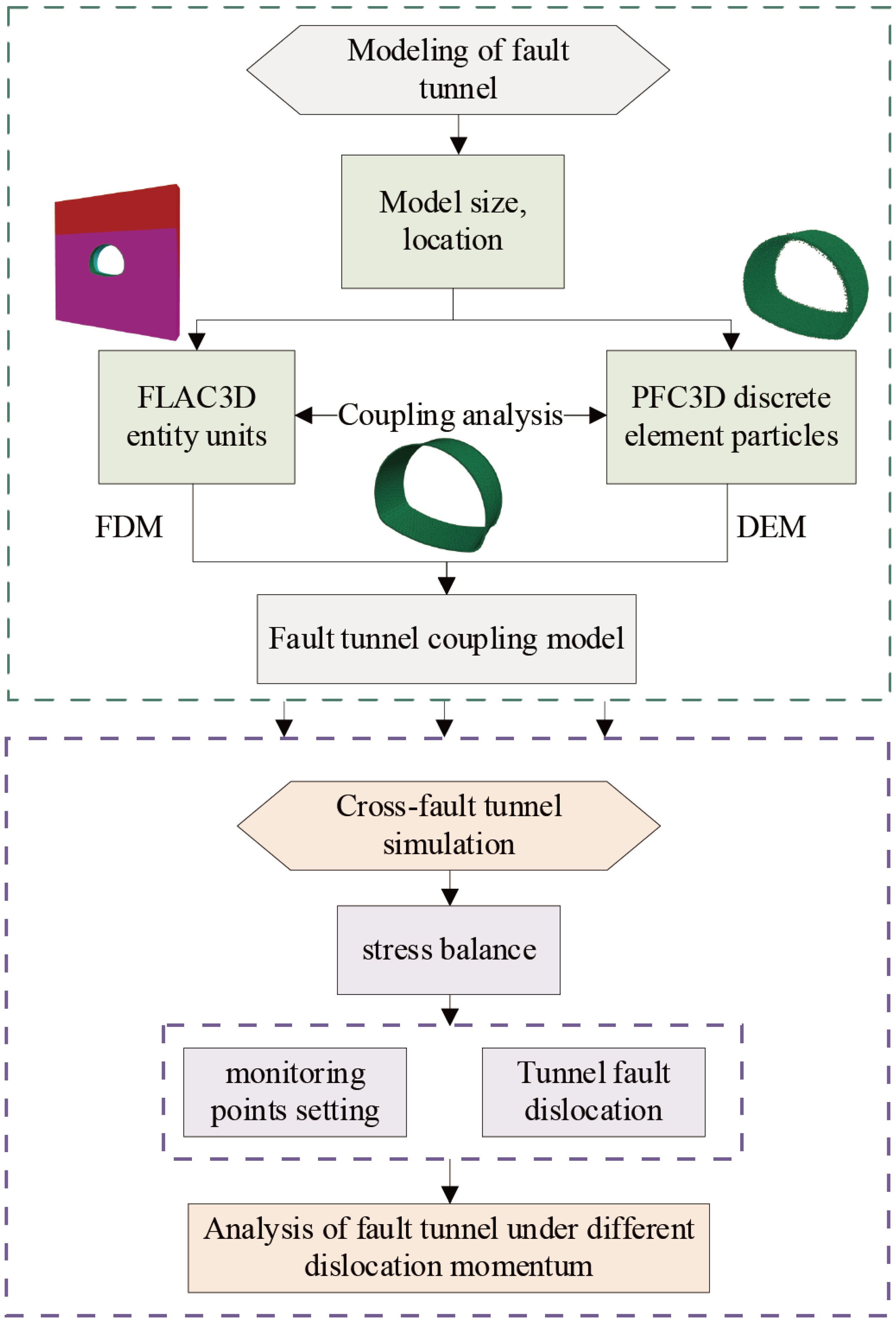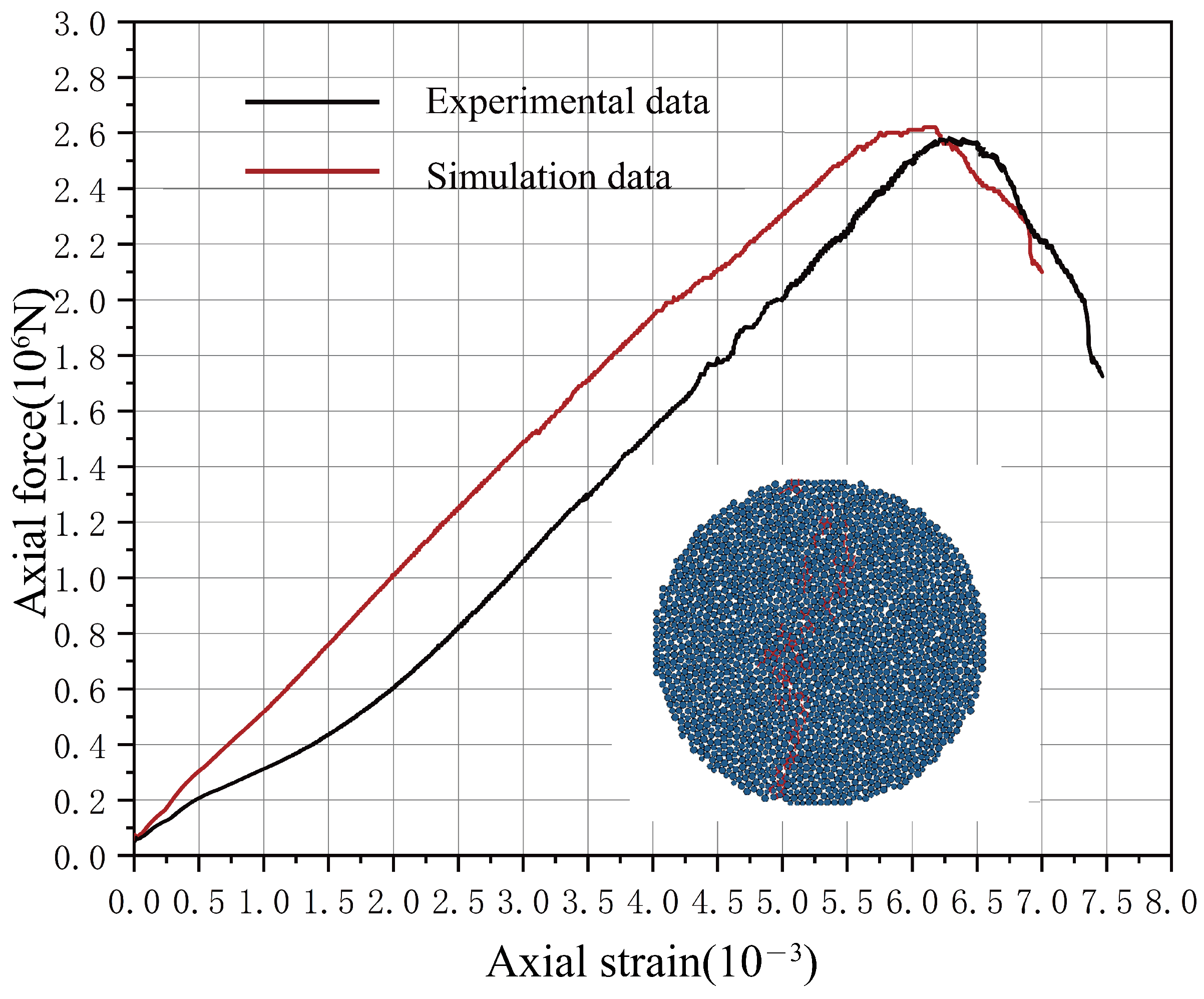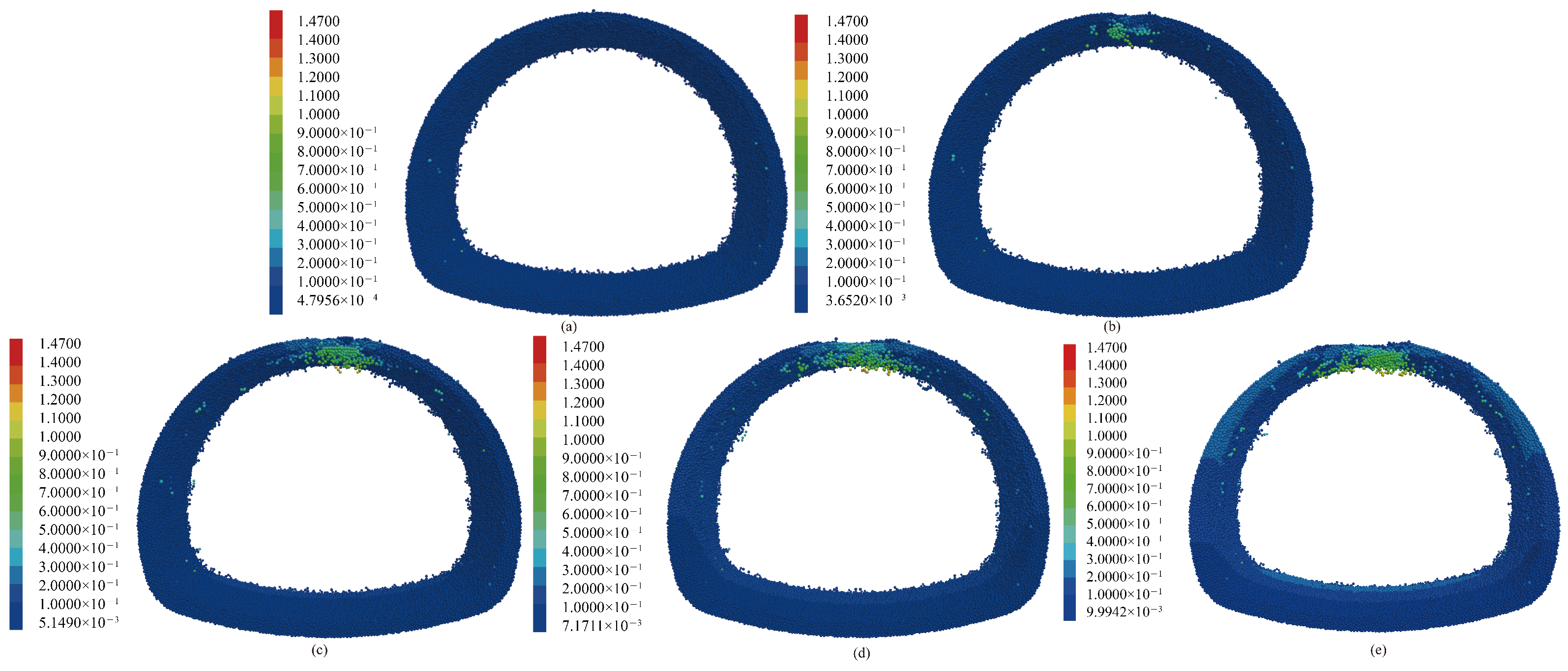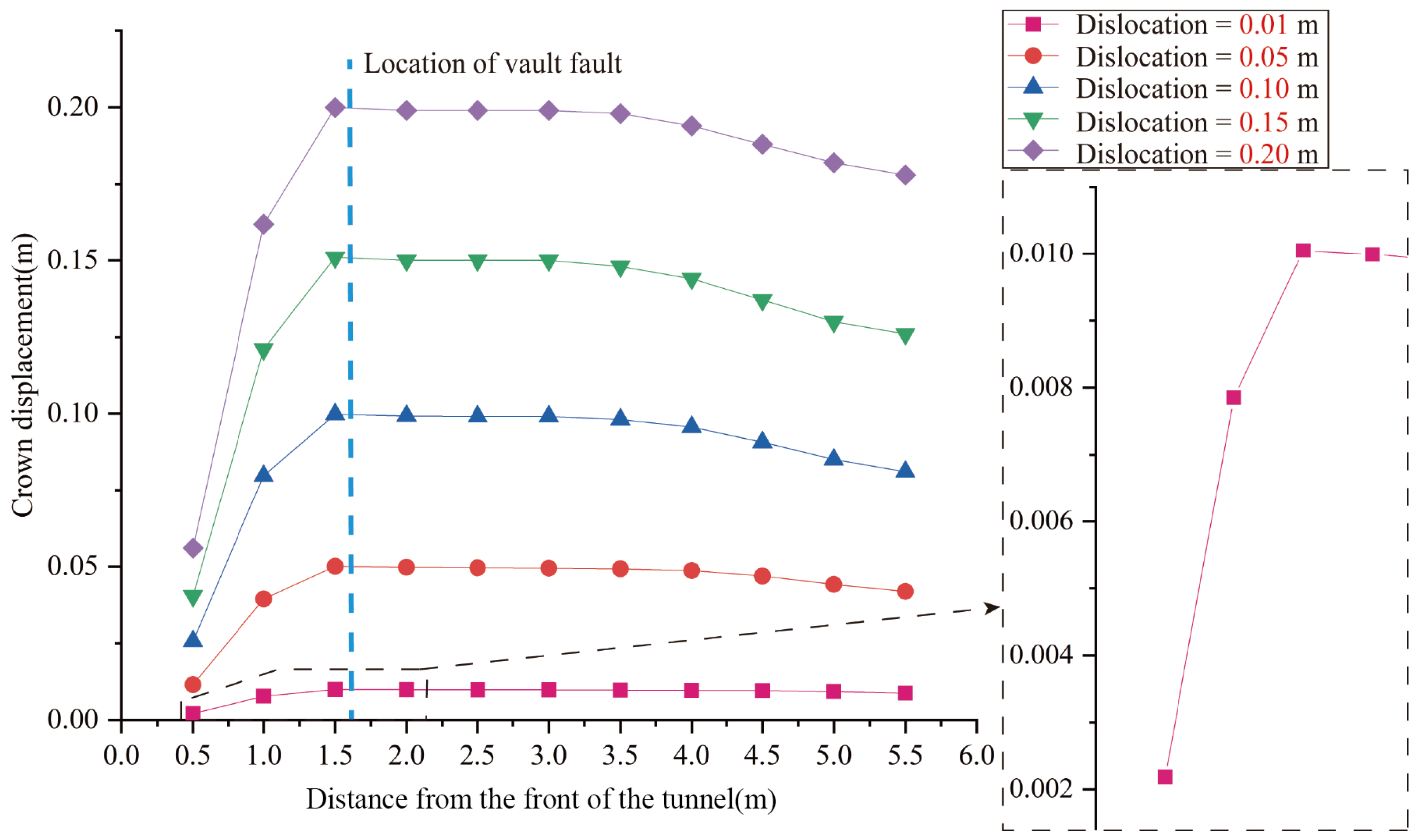Research on the Stability of Lining Structures Under Different Fault Moments Based on FDM-DEM
Abstract
1. Introduction
2. Project Profile
3. Research Program
3.1. Modeling, Research Programs
3.2. Geometric Size of the Model
- (1)
- The upper and lower walls of the model fault were assumed to be isotropic and to exhibit a continuous linear elastic behavior;
- (2)
- It was presumed that the fault movement occurs at a constant rate;
- (3)
- The boundary conditions for the lower wall of the fault were considered to be entirely fixed.
4. FDM-DEM Model Construction
4.1. Construction of Macro and Micro Parameters
4.2. Construction of Coupling Model
5. Results Analysis and Discussion
5.1. Displacement Characteristics
5.2. Force Chain and Crack Analysis
5.3. Analysis of Safety Coefficient
6. Conclusions
- (1)
- As the fault dislocation increased, the displacement around the tunnel significantly intensified, leading to a gradual expansion of the fracture zone at the tunnel front and spreading both in the depth direction and towards the spandrel area. Especially under conditions of significant dislocation momentum (e.g., 0.15 m and 0.2 m), the scope of the fracture zone dramatically increased, signifying that the tunnel structure endured substantial damage and deterioration;
- (2)
- As the fault dislocation progressed, the particle contact force within the tunnel lining gradually transitioned from compression to tension. This shift in mechanical state was the primary cause of the crack formation. Under conditions of significant misalignment momentum (e.g., 0.15 m and 0.2 m), the tensile effect of the contact force started to intensify, leading to the appearance and expansion of a large number of cracks in the lining structure, with a significant increase in both the quantity and width of cracks;
- (3)
- The evolution of cracks exhibited characteristics of dynamic, gradual failure: when the dislocation momentum was low (e.g., 0.01 m), the lining structure remained nearly intact. However, as the dislocation momentum gradually increased (especially at 0.15 m and 0.2 m), cracks began to propagate from the vault towards the spandrel and arch waist areas, with a significant increase in crack width. This demonstrates that under conditions of significant dislocation momentum, the overall stability of the tunnel lining greatly diminished. This approach transcends the limitations of traditional finite element analysis by employing discrete elements to monitor the development of tunnel cracks, enabling the identification of weak points in the tunnel lining’s failure, which is beneficial for prioritizing protection during the construction process.
- (4)
- The safety factor at the faulted section of the tunnel was significantly diminished, reaching its lowest value of 2.32 when the dislocation momentum was 0.2 m. Changes in the plastic zone, particularly at the top of the tunnel, also indicated that as the dislocation momentum increased, the stability of the tunnel lining was progressively compromised, with the failure effect at the vault becoming more pronounced. This demonstrates that the stress distribution within a tunnel lining varies considerably under different dislocation momenta and should be flexibly considered during the design of the tunnel lining structure. These findings underscore the critical importance of monitoring and managing misalignment momentum to ensure the safety of tunnel structures.
Author Contributions
Funding
Data Availability Statement
Conflicts of Interest
References
- Hepburn, C.; Qi, Y.; Stern, N.; Ward, B.; Xie, C.; Zenghelis, D. Towards carbon neutrality and China’s 14th Five-Year Plan: Clean energy transition, sustainable urban development, and investment priorities. Environ. Sci. Ecotechnol. 2021, 8, 100130. [Google Scholar] [CrossRef] [PubMed]
- Li, G.; Wang, A.; Gao, Y. Source rupture characteristics of the September 5, 2022 Luding MS 6.8 earthquake at the Xianshuihe fault zone in southwest China. Earthq. Res. Adv. 2023, 3, 100201. [Google Scholar] [CrossRef]
- Chen, P.; Geng, P.; Chen, J.; Gu, W. The seismic damage mechanism of Daliang tunnel by fault dislocation during the 2022 Menyuan Ms6. 9 earthquake based on unidirectional velocity pulse input. Eng. Fail. Anal. 2023, 145, 107047. [Google Scholar] [CrossRef]
- Sahoo, J.P.; Gowtham, G. Stability evaluation of circular tunnels in cohesive frictional soil under earthquake loading using the modified pseudo-dynamic approach. Soil Dyn. Earthq. Eng. 2023, 166, 107740. [Google Scholar] [CrossRef]
- Yu, H.; Chen, J.; Bobet, A.; Yuan, Y. Damage observation and assessment of the Longxi tunnel during the Wenchuan earthquake. Tunn. Undergr. Space Technol. 2016, 54, 102–116. [Google Scholar] [CrossRef]
- Brandes, C.; Polom, U.; Winsemann, J.; Sandersen, P.B. The near-surface structure in the area of the Børglum fault, Sorgenfrei-Tornquist Zone, northern Denmark: Implications for fault kinematics, timing of fault activity and fault control on tunnel valley formation. Quat. Sci. Rev. 2022, 289, 107619. [Google Scholar] [CrossRef]
- Wang, Y.; Li, J.; Wang, Z.F.; Chang, H. Structural failures and geohazards caused by mountain tunnel construction in fault zone and its treatment measures: A case study in Shaanxi. Eng. Fail. Anal. 2022, 138, 106386. [Google Scholar] [CrossRef]
- Zeng, G.; Geng, P.; Guo, X.; Li, P.; Wang, Q.; Ding, T. An anti-fault study of basalt fiber reinforced concrete in tunnels crossing a stick-slip fault. Soil Dyn. Earthq. Eng. 2021, 148, 106687. [Google Scholar] [CrossRef]
- Baziar, M.H.; Nabizadeh, A.; Mehrabi, R.; Lee, C.J.; Hung, W.Y. Evaluation of underground tunnel response to reverse fault rupture using numerical approach. Soil Dyn. Earthq. Eng. 2016, 83, 1–17. [Google Scholar] [CrossRef]
- Liu, X.; Li, X.; Sang, Y.; Lin, L. Experimental study on normal fault rupture propagation in loose strata and its impact on mountain tunnels. Tunn. Undergr. Space Technol. 2015, 49, 417–425. [Google Scholar] [CrossRef]
- Manouchehrian, A.; Cai, M. Numerical modeling of rockburst near fault zones in deep tunnels. Tunn. Undergr. Space Technol. 2018, 80, 164–180. [Google Scholar] [CrossRef]
- Zhang, Y.; Zhang, Z.; Yin, C.; Wei, R.; Zhang, H. Experimental study on forced response characteristics and anti-dislocation performance of articulated tunnel structure under dislocation action of normal fault. In Structures; Elsevier: Amsterdam, The Netherlands, 2023; Volume 48, pp. 867–881. [Google Scholar]
- Zhang, Z.; Zhang, Y.; Wei, R.; Yin, C.; Zhang, H. The damage mode and forced response characteristics of articulated lining structure: A case study of metro tunnel under a reverse fault action. Tunn. Undergr. Space Technol. 2023, 140, 105246. [Google Scholar] [CrossRef]
- Zhao, X.; Li, R.; Yuan, Y.; Yu, H.; Zhao, M.; Huang, J. Shaking table tests on fault-crossing tunnels and aseismic effect of grouting. Tunn. Undergr. Space Technol. 2022, 125, 104511. [Google Scholar] [CrossRef]
- Yan, G.; Zhao, B.; Wang, Z.; Gao, B. Simplified analytical solution for responses of fault-crossing tunnels with flexible joints under fault movement. In Structures; Elsevier: Amsterdam, The Netherlands, 2022; Volume 45, pp. 984–998. [Google Scholar]
- Wang, T.; Geng, P.; Li, P.; Wang, Q.; Wang, L. Deformation and failure of overburden soil subjected to normal fault dislocation and its impact on tunnel. Eng. Fail. Anal. 2022, 142, 106747. [Google Scholar] [CrossRef]
- Fang, X.; Yang, J.; Zhang, X.; Zhang, C.; Wang, S.; Xie, Y. Numerical modeling of open TBM tunneling in stratified rock masses using a coupled FDM-DEM method. Comput. Geotech. 2023, 156, 105251. [Google Scholar] [CrossRef]
- Lee, H.; Kim, H.K.; Hwang, B.; Yoon, Y.; Choi, H. Coupled DEM-FDM numerical model for EPB shield tunnelling simulation with foam conditioning. Tunn. Undergr. Space Technol. 2024, 147, 105718. [Google Scholar] [CrossRef]
- Yan, B.; Wang, R.; Ding, B.s.; Dai, F.; Wang, Y. Numerical simulation analysis of tunnel backfill grout based on DEM-FDM coupling and particle inlet. Undergr. Space 2024, 14, 285–299. [Google Scholar] [CrossRef]
- Yin, Z.Y.; Wang, P.; Zhang, F. Effect of particle shape on the progressive failure of shield tunnel face in granular soils by coupled FDM-DEM method. Tunn. Undergr. Space Technol. 2020, 100, 103394. [Google Scholar] [CrossRef]
- Liu, B.; Meng, W.; Zhao, Z.; Lin, T.; Zhang, J. Coupled thermal-hydro-mechanical modeling on characteristics of excavation damage zone around deep tunnels crossing a major fault. Tunn. Undergr. Space Technol. 2023, 134, 105008. [Google Scholar] [CrossRef]
- Sun, B.; Deng, M.; Zhang, S.; Wang, C.; Cui, W.; Li, Q.; Xu, J.; Zhao, X.; Yan, H. Optimal selection of scalar and vector-valued intensity measures for improved fragility analysis in cross-fault hydraulic tunnels. Tunn. Undergr. Space Technol. 2023, 132, 104857. [Google Scholar] [CrossRef]
- Chen, L.; Wang, Y.; Wang, Z.; Fan, F.; Liu, Y. Characteristics and treatment measures of tunnel collapse in fault fracture zone during rainfall: A case study. Eng. Fail. Anal. 2023, 145, 107002. [Google Scholar] [CrossRef]
- Huang, F.; Wu, C.; Jang, B.A.; Hong, Y.; Guo, N.; Guo, W. Instability mechanism of shallow tunnel in soft rock subjected to surcharge loads. Tunn. Undergr. Space Technol. 2020, 99, 103350. [Google Scholar] [CrossRef]
















| Name | Volumetric Weight/(kN·m−3) | Elastic Modulus/GPa | Poisson Ratio | Angle of Internal Friction/(°) | Cohesion/MPa |
|---|---|---|---|---|---|
| sandstone | 25 | 8.5 | 0.48 | 30 | 5 |
| Name | Volumetric Weight/(kN·m−3) | Elastic Modulus/GPa | Poisson Ratio | Compressive Yield Stress/MPa | Tensile Yield Stress/MPa |
|---|---|---|---|---|---|
| primary lining | 24 | 28 | 0.13 | 16.7 | 1.78 |
| secondary lining | 25 | 30 | 0.15 | 20.1 | 2.01 |
| anchor bar | 38.5 | 200 | 0.3 |
| Mesoscopic Parameters | Taking Values | Mesoscopic Parameters | Taking Values |
|---|---|---|---|
| Rmin (cm) | 5 | Pb_emod (Gpa) | 3.65 |
| Rmax (cm) | 7 | Pb_kratio | 1.97 |
| porosity | 0.03 | Pb_ten (Mpa) | 1.05 |
| density (kg/m3) | 25 | Pb_coh (Mpa) | 50 |
| fric | 0.6 | Pb_fa | 40 |
| emod (Gpa) | 3.19 | kratio | 1.58 |
| Dislocation | Axial Force (N) | ||||
|---|---|---|---|---|---|
| Monitoring Point 1 | Monitoring Point 2 | Monitoring Point 3 | Monitoring Point 4 | Monitoring Point 5 | |
| 0.01 m | 57,242.64 | 81,777.26 | 7,903,525.25 | 131,219.87 | 57,439.52 |
| 0.05 m | 77,850.17 | 138,367.82 | 8,030,244.14 | 193,893.48 | 79,787.62 |
| 0.10 m | 88,205.86 | 299,059.51 | 8,240,239.66 | 369,925.09 | 148,322.33 |
| 0.15 m | 95,000.06 | 366,353.41 | 8,358,759.49 | 464,925.09 | 321,333.07 |
| 0.20 m | 98,659.10 | 549,124.89 | 8,616,360.41 | 580,916.30 | 410,469.27 |
| Dislocation | Factor of Safety K | ||||
|---|---|---|---|---|---|
| Monitoring Point 1 | Monitoring Point 2 | Monitoring Point 3 | Monitoring Point 4 | Monitoring Point 5 | |
| 0.01 m | 349.39 | 244.57 | 2.53 | 152.42 | 348.19 |
| 0.05 m | 256.90 | 144.54 | 2.49 | 103.15 | 250.67 |
| 0.10 m | 226.74 | 66.88 | 2.43 | 54.06 | 134.84 |
| 0.15 m | 210.53 | 54.59 | 2.39 | 43.02 | 62.24 |
| 0.20 m | 202.72 | 36.42 | 2.32 | 34.43 | 48.72 |
Disclaimer/Publisher’s Note: The statements, opinions and data contained in all publications are solely those of the individual author(s) and contributor(s) and not of MDPI and/or the editor(s). MDPI and/or the editor(s) disclaim responsibility for any injury to people or property resulting from any ideas, methods, instructions or products referred to in the content. |
© 2024 by the authors. Licensee MDPI, Basel, Switzerland. This article is an open access article distributed under the terms and conditions of the Creative Commons Attribution (CC BY) license (https://creativecommons.org/licenses/by/4.0/).
Share and Cite
Mao, W.; Ren, Z.; Liu, X.; Muhemaier, R.; Li, Y.; Jiang, C. Research on the Stability of Lining Structures Under Different Fault Moments Based on FDM-DEM. Buildings 2024, 14, 3429. https://doi.org/10.3390/buildings14113429
Mao W, Ren Z, Liu X, Muhemaier R, Li Y, Jiang C. Research on the Stability of Lining Structures Under Different Fault Moments Based on FDM-DEM. Buildings. 2024; 14(11):3429. https://doi.org/10.3390/buildings14113429
Chicago/Turabian StyleMao, Wei, Zulin Ren, Xuejun Liu, Ruheiyan Muhemaier, Yanjun Li, and Chaoteng Jiang. 2024. "Research on the Stability of Lining Structures Under Different Fault Moments Based on FDM-DEM" Buildings 14, no. 11: 3429. https://doi.org/10.3390/buildings14113429
APA StyleMao, W., Ren, Z., Liu, X., Muhemaier, R., Li, Y., & Jiang, C. (2024). Research on the Stability of Lining Structures Under Different Fault Moments Based on FDM-DEM. Buildings, 14(11), 3429. https://doi.org/10.3390/buildings14113429






